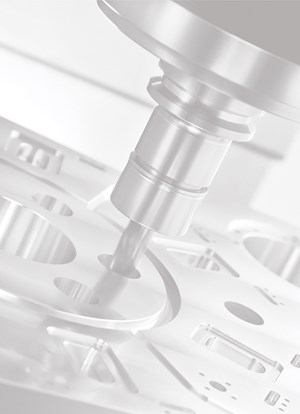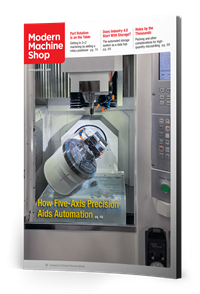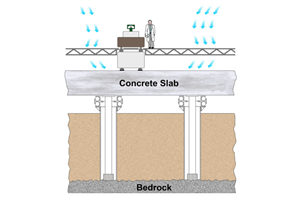Tips for Ensuring the Performance of a Surface Finish Measuring System
Industry standards for surface finish help define the specifications of the instruments, how they are used, the results they provide and how they can be tested for performance.
Share







Solving problems is a common task for those manufacturing and selling tools that measure surface finish. For example, there are always new employees joining manufacturing companies who need to become proficient in surface measurement. Or a surface measuring tool has been transferred from one facility to another with instructions to put the new tool into immediate use.
Thus, the nature of our business is to help the user get the tool running as quickly as possible. The most common way to do this is to start with the basics and walk the user through some straightforward calibration steps to get things moving in the right direction.
One of the great things about measuring surface finish is that industry standards clearly define the process and parameters. These standards help define the specifications of the instruments, how they are used, the results they provide and how they can be tested for performance. They describe an approach to measuring surface roughness and the calibration process.
Every machining operation leaves its mark, and the surface finish is made up of a series of peaks and valleys machined or otherwise manufactured on the surface of the part. Surface calibration standards, specimens or patches contain peaks and valleys in various shapes and amplitudes that are precisely machined, then measured and certified as traceable to international standards. The calibration process verifies that the surface finish instrument is producing accurate results.
Calibration is a great starting point for getting a new user familiar with and comfortable using the surface measuring system. There are two basic types of surface finish gages: skid-type, or averaging systems, and skidless, or profiling systems. Skidded gages have a hinged probe assembly, with the probe riding next to a relatively broad skid that also contacts the workpiece. The skid tends to filter out waviness, so the probe measures only short-wavelength variations. But at this point, you need to make proper measurements using the certified calibration standard.
The most common roughness standard is the triangular style, with rounded peaks and valleys. These specimens are typically referred to as “C3 Style” grooves and come in various grades of roughness. Examples include Ra values of 0.5, 0.9, 2.5, 3.0 or 3.2 µm. Therefore, the goal is to help the user set up the surface system so that, when utilizing the certified patch, they obtain the correct values on their instrument.
The checking process is fairly simple: Just make a measurement of the surface reference specimen with the instrument using the Ra parameter and see what you get. Each reference specimen comes with a certificate of the measured Ra value. After the test, compare the results. It should be within the percentage of error as specified by your instrument’s manufacturer. With proper instruction and guidance, you can coach the user to set up the system and measure the standard properly.
If the user goes through the process, but does not get the right results, perform the calibration procedure again and then re-measure the reference specimen. If the results are still not accurate, usually a limited amount of adjustment to the calibration standard is necessary. Using the system method, instruct the user to fine-tune the calibration. If the system still does not achieve the correct results, then there may be an issue with the unit or the probe, and more troubleshooting is needed.
If, after adjusting calibration, the result is not correct, it probably is not the calibration but rather that the diamond radius tip is starting to wear. As the diamond wears or becomes chipped, it will either span or go further into the valleys and give improper results. If possible, grab another probe and check the results with this. The new probe may have a correct stylus and work fine.
It could also be the result of a worn patch. Patches, like any other standard, need to be verified on a regular basis. Often, users check the patch in the center, and this area will eventually wear out. Checking near the sides of the patch may be less worn and provide a better result.
Inspecting the probe and the patch is certainly the most common method to get on the path to making good surface roughness measurements. Measuring the part is the next challenge once the user is comfortable and trusts these results. In this phase, a whole new series of challenges can take place, and these topics will be discussed in a future column.
Related Content
How to Calibrate Gages and Certify Calibration Programs
Tips for establishing and maintaining a regular gage calibration program.
Read MoreThe Many Ways of Measuring Thickness
While it may seem to be a straightforward check, there are many approaches to measuring thickness that are determined by the requirements of the part.
Read MoreOrthopedic Event Discusses Manufacturing Strategies
At the seminar, representatives from multiple companies discussed strategies for making orthopedic devices accurately and efficiently.
Read MoreHow to Evaluate Measurement Uncertainty
Manufacturing and measurement are closely coupled. An important consideration for the use of measurement results is the associated measurement uncertainty. This article describes common metrology terms and provides an example uncertainty analysis.
Read MoreRead Next
View From My Shop: The Challenge of a One-Man Machine Shop
Mason Montalvo took up the challenge of starting his own shop running manual machine tools to produce complex parts.
Read More2025 Top Shops Benchmarking Survey Now Open Through April 30
91ÊÓƵÍøÕ¾ÎÛ's Top Shops Benchmarking Survey is now open, offering metalworking and machining operations actionable feedback across several shopfloor and business metrics.
Read More




















